Micro-Computed Tomography Analysis of Reciprocating Systems in Three-Dimensional Models of Mandibular Premolars with Two Canals
Abstract
1. Introduction
2. Materials and Methods
2.1. The Sample Selection
2.2. 3D Resin Model Preparation
2.3. Chemomechanical Preparation of Root Canals
- -
- WaveOne Gold Group (WOG): The WOG was used according to the manufacturer’s instructions. Instrumentation was performed with a ZEvo motor (Zarc4endo, Gijón, Spain) at 400 rpm, with a reciprocating motion of 170° counterclockwise and 50° clockwise. The WOG Glider (15/0.02) and Primary (25/0.07) files were used consecutively. At each 3–4 mm movement of the file, irrigation with 1 mL of 4.2% sodium hypochlorite (NaOCl) was performed with a Navitip 30G needle (Ultradent, South Jordan, UT, USA), followed by patency with a K-type file No. 10 at WL + 1 mm.
- -
- Reciproc Blue Group: The Reciproc Blue System used an R25 (25/0.08) file in reciprocating motion, with 150° counterclockwise rotations and 30° clockwise rotations at 400 rpm with three strokes. After removing each file from the canal, it was rinsed with 1 mL of NaOCl (4.2%), followed by patency with a K-type file No. 10.
- -
- Excalibur group: Instrumentation with the Excalibur system was performed with a ZEvo motor at 500 rpm with reciprocating movements of 150° counterclockwise and 30° clockwise with in and out movements. The system used E20 (20/0.05) and E25 (25/0.05) files, and irrigation with NaOCl (4.2%) was repeated at 3–4 mm intervals.
- -
- One Reci group: The One Reci system used One Flare (17/0.09) and One G (14/0.03) files for glide path preparation, followed by One Reci (25/0.06). The files were operated at 400 rpm, with 170° counterclockwise rotations and 60° clockwise rotations, and irrigation was performed similarly to the other groups.
2.4. Micro-CT Scanning
2.5. Screw-In Sensation and Instrumentation Time
2.6. Statistical Analysis
3. Results
3.1. Volume and Surface Area Changes
- -
- In the total canal length (10 mm), the volume increased by 90.36% with Reciproc Blue, followed by 89.3% for One Reci, 86.75% for Excalibur, and 86.54% for WaveOne Gold (Figure 2A,B).
- -
- In the apical third (4 mm), the volume increase was highest for One Reci at 100.67%, followed by 95.24% for WaveOne Gold, 90.64% for Reciproc Blue, and 89.41% for Excalibur.
- -
- For the entire canal length (10 mm), WaveOne Gold increased the surface area by 55.36%, Excalibur by 54.78%, One Reci by 57.49%, and Reciproc Blue by 61.05%.
- -
- In the apical third (4 mm), the increases amounted to 78.90% for WaveOne Gold, 73.93% for One Reci, 67.29% for Reciproc Blue and 63.71% for Excalibur.
3.2. Unprepared Canal Walls
3.3. Pericervical Resin Conservation
3.4. Screw-In Sensation
3.5. Instrumentation Time
4. Discussion
5. Conclusions
Supplementary Materials
Author Contributions
Funding
Institutional Review Board Statement
Informed Consent Statement
Data Availability Statement
Conflicts of Interest
References
- Martins, J.N.R.; Zhang, Y.; von Zuben, M.; Vargas, W.; Seedat, H.C.; Santiago, F.; Aguilar, R.R.; Ragnarsson, M.F.; Plotino, G.; Parashos, P.; et al. Worldwide Prevalence of a Lingual Canal in Mandibular Premolars: A Multicenter Cross-sectional Study with Meta-analysis. J. Endod. 2021, 47, 1253–1264. [Google Scholar] [CrossRef] [PubMed]
- Baisden, M.K.; Kulild, J.C.; Weller, R.N. Root canal configuration of the mandibular first premolar. J. Endod. 1992, 18, 505–508. [Google Scholar] [CrossRef]
- Costa, F.; Pacheco-Yanes, J.; Siqueira, J.F., Jr.; Oliveira, A.C.S.; Gazzaneo, I.; Amorim, C.A.; Santos, P.H.B.; Alves, F.R.F. Association between missed canals and apical periodontitis. Int. Endod. J. 2019, 52, 400–406. [Google Scholar] [CrossRef] [PubMed]
- Siqueira, J.F., Jr.; Antunes, H.S.; Pérez, A.R.; Alves, F.R.F.; Mdala, I.; Silva, E.; Belladonna, F.G.; Rôças, I.N. The Apical Root Canal System of Teeth with Posttreatment Apical Periodontitis: Correlating Microbiologic, Tomographic, and Histopathologic Findings. J. Endod. 2020, 46, 1195–1203. [Google Scholar] [CrossRef] [PubMed]
- Li, X.; Liu, N.; Liu, N.; Ye, L.; Nie, X.; Zhou, X.; Wen, X.; Liu, R.; Liu, L.; Deng, M. A micro-computed tomography study of the location and curvature of the lingual canal in the mandibular first premolar with two canals originating from a single canal. J. Endod. 2012, 38, 309–312. [Google Scholar] [CrossRef]
- Siqueira, J.F., Jr.; Pérez, A.R.; Marceliano-Alves, M.F.; Provenzano, J.C.; Silva, S.G.; Pires, F.R.; Vieira, G.C.S.; Rôças, I.N.; Alves, F.R.F. What happens to unprepared root canal walls: A correlative analysis using micro-computed tomography and histology/scanning electron microscopy. Int. Endod. J. 2018, 51, 501–508. [Google Scholar] [CrossRef]
- Patel, S.; Brown, J.; Pimentel, T.; Kelly, R.D.; Abella, F.; Durack, C. Cone beam computed tomography in Endodontics—A review of the literature. Int. Endod. J. 2019, 52, 1138–1152. [Google Scholar] [CrossRef]
- Rhodes, J.S.; Ford, T.R.; Lynch, J.A.; Liepins, P.J.; Curtis, R.V. Micro-computed tomography: A new tool for experimental endodontology. Int. Endod. J. 1999, 32, 165–170. [Google Scholar] [CrossRef]
- Guimarães, L.S.; Gomes, C.C.; Marceliano-Alves, M.F.; Cunha, R.S.; Provenzano, J.C.; Siqueira, J.F., Jr. Preparation of oval-shaped canals with Trushape and Reciproc systems: A micro-computed tomography study using contralateral premolars. J. Endod. 2017, 43, 1018–1022. [Google Scholar] [CrossRef]
- Clark, D.; Khademi, J. Modern molar endodontic access and directed dentin conservation. Dent. Clin. N. Am. 2010, 54, 249–273. [Google Scholar] [CrossRef]
- Panitvisai, P.; Messer, H.H. Cuspal deflection in molars in relation to endodontic and restorative procedures. J. Endod. 1995, 21, 57–61. [Google Scholar] [CrossRef] [PubMed]
- Aazzouzi-Raiss, K.; Ramírez-Muñoz, A.; Mendez, S.P.; Vieira, G.C.S.; Aranguren, J.; Pérez, A.R. Effects of Conservative Access and Apical Enlargement on Shaping and Dentin Preservation with Traditional and Modern Instruments: A Micro-computed Tomographic Study. J. Endod. 2023, 49, 430–437. [Google Scholar] [CrossRef] [PubMed]
- Rover, G.; Belladonna, F.G.; Bortoluzzi, E.A.; De-Deus, G.; Silva, E.; Teixeira, C.S. Influence of Access Cavity Design on Root Canal Detection, Instrumentation Efficacy, and Fracture Resistance Assessed in Maxillary Molars. J. Endod. 2017, 43, 1657–1662. [Google Scholar] [CrossRef]
- Wang, Y.; Lu, Y.; Gu, Y.; Cai, Y.; Zhang, C.; Li, J. Finding appropriate nickel-titanium instruments for lingual canals in mandibular first premolars with two canals: A micro-CT study. Aust. Endod. J. 2023, 49 (Suppl. S1), 89–98. [Google Scholar] [CrossRef]
- Silva, E.; Vieira, V.T.L.; Hecksher, F.; Dos Santos Oliveira, M.R.S.; Dos Santos Antunes, H.; Moreira, E.J.L. Cyclic fatigue using severely curved canals and torsional resistance of thermally treated reciprocating instruments. Clin. Oral. Investig. 2018, 22, 2633–2638. [Google Scholar] [CrossRef]
- You, S.Y.; Kim, H.C.; Bae, K.S.; Baek, S.H.; Kum, K.Y.; Lee, W. Shaping ability of reciprocating motion in curved root canals: A comparative study with micro-computed tomography. J. Endod. 2011, 37, 1296–1300. [Google Scholar] [CrossRef]
- Peters, O.A.; Boessler, C.; Paque, F. Root canal preparation with a novel nickel-titanium instrument evaluated with micro-computed tomography: Canal surface preparation over time. J. Endod. 2010, 36, 1068–1072. [Google Scholar] [CrossRef]
- Gergi, R.; Osta, N.; Bourbouze, G.; Zgheib, C.; Arbab-Chirani, R.; Naaman, A. Effects of three nickel titanium instrument systems on root canal geometry assessed by micro-computed tomography. Int. Endod. J. 2015, 48, 162–170. [Google Scholar] [CrossRef]
- Vertucci, F.J. Root canal anatomy of the human permanent teeth. Oral. Surg. Oral. Med. Oral. Pathol. 1984, 58, 589–599. [Google Scholar] [CrossRef]
- DeWald, J.P. The use of extracted teeth for in vitro bonding studies: A review of infection control considerations. Dent. Mater. 1997, 13, 74–81. [Google Scholar] [CrossRef]
- Spenst, A.; Kahn, H. The use of a plastic block for teaching root canal instrumentation and obturation. J. Endod. 1979, 5, 282–284. [Google Scholar] [CrossRef] [PubMed]
- Reymus, M.; Fotiadou, C.; Kessler, A.; Heck, K.; Hickel, R.; Diegritz, C. 3D printed replicas for endodontic education. Int. Endod. J. 2019, 52, 123–130. [Google Scholar] [CrossRef] [PubMed]
- Kessler, A.; Hickel, R.; Reymus, M. 3D Printing in Dentistry-State of the Art. Oper. Dent. 2020, 45, 30–40. [Google Scholar] [CrossRef]
- Kooanantkul, C.; Shelton, R.M.; Camilleri, J. Comparison of obturation quality in natural and replica teeth root-filled using different sealers and techniques. Clin. Oral. Investig. 2023, 27, 2407–2417. [Google Scholar] [CrossRef]
- Cui, Z.; Wei, Z.; Du, M.; Yan, P.; Jiang, H. Shaping ability of protaper next compared with waveone in late-model three-dimensional printed teeth. BMC Oral. Health 2018, 18, 115. [Google Scholar] [CrossRef]
- Nassri, M.R.; Carlik, J.; da Silva, C.R.; Okagawa, R.E.; Lin, S. Critical analysis of artificial teeth for endodontic teaching. J. Appl. Oral. Sci. 2008, 16, 43–49. [Google Scholar] [CrossRef]
- Bitter, K.; Gruner, D.; Wolf, O.; Schwendicke, F. Artificial Versus Natural Teeth for Preclinical Endodontic Training: A Randomized Controlled Trial. J. Endod. 2016, 42, 1212–1217. [Google Scholar] [CrossRef]
- Ramírez-Muñoz, A.; Escribano-Capdevila, M.; Navarrete, N.; Vieira, G.C.S.; Salamanca-Ramos, M.; Ortolani-Seltenerich, P.S.; Aranguren, J.; Pérez, A.R. Comparative Micro-CT Analysis of Minimally Invasive Endodontic Systems Using 3D-Printed Replicas and Natural Teeth. Materials 2024, 17, 5279. [Google Scholar] [CrossRef]
- Höhne, C.; Schmitter, M. 3D Printed Teeth for the Preclinical Education of Dental Students. J. Dent. Educ. 2019, 83, 1100–1106. [Google Scholar] [CrossRef]
- Busquim, S.; Cunha, R.S.; Freire, L.; Gavini, G.; Machado, M.E.; Santos, M. A micro-computed tomography evaluation of long-oval canal preparation using reciprocating or rotary systems. Int. Endod. J. 2015, 48, 1001–1006. [Google Scholar] [CrossRef]
- Amoroso-Silva, P.; Alcalde, M.P.; Hungaro Duarte, M.A.; De-Deus, G.; Ordinola-Zapata, R.; Freire, L.G.; Cavenago, B.C.; De Moraes, I.G. Effect of finishing instrumentation using NiTi hand files on volume, surface area and uninstrumented surfaces in C-shaped root canal systems. Int. Endod. J. 2017, 50, 604–611. [Google Scholar] [CrossRef] [PubMed]
- Pérez, A.R.; Ricucci, D.; Vieira, G.C.S.; Provenzano, J.C.; Alves, F.R.F.; Marceliano-Alves, M.F.; Rôças, I.N.; Siqueira, J.F., Jr. Cleaning, Shaping, and Disinfecting Abilities of 2 Instrument Systems as Evaluated by a Correlative Micro-computed Tomographic and Histobacteriologic Approach. J. Endod. 2020, 46, 846–857. [Google Scholar] [CrossRef] [PubMed]
- Rodrigues, R.C.V.; Zandi, H.; Kristoffersen, A.K.; Enersen, M.; Mdala, I.; Ørstavik, D.; Rôças, I.N.; Siqueira, J.F., Jr. Influence of the apical preparation size and the irrigant type on bacterial reduction in root canal-treated teeth with apical periodontitis. J. Endod. 2017, 43, 1058–1063. [Google Scholar] [CrossRef]
- Siqueira, J.F., Jr.; Alves, F.R.; Versiani, M.A.; Rôças, I.N.; Almeida, B.M.; Neves, M.A.; Sousa-Neto, M.D. Correlative bacteriologic and micro-computed tomographic analysis of mandibular molar mesial canals prepared by self-adjusting file, reciproc, and twisted file systems. J. Endod. 2013, 39, 1044–1050. [Google Scholar] [CrossRef]
- Alghamdi, A.; Alsofi, L.; Balto, K. Effects of a Novel NiTi Thermomechanical Treatment on the Geometric Features of the Prepared Root Canal System. Materials 2020, 13, 5546. [Google Scholar] [CrossRef]
- Lacerda, M.; Marceliano-Alves, M.F.; Pérez, A.R.; Provenzano, J.C.; Neves, M.A.S.; Pires, F.R.; Gonçalves, L.S.; Rôças, I.N.; Siqueira, J.F., Jr. Cleaning and shaping oval canals with 3 instrumentation systems: A correlative micro-computed tomographic and histologic study. J. Endod. 2017, 43, 1878–1884. [Google Scholar] [CrossRef]
- Campello, A.F.; Marceliano-Alves, M.F.; Siqueira, J.F., Jr.; Fonseca, S.C.; Lopes, R.T.; Alves, F.R.F. Unprepared surface areas, accumulated hard tissue debris, and dentinal crack formation after preparation using reciprocating or rotary instruments: A study in human cadavers. Clin. Oral. Investig. 2021, 25, 6239–6248. [Google Scholar] [CrossRef]
- Varela, P.; Souza, E.; de Deus, G.; Duran-Sindreu, F.; Mercade, M. Effectiveness of complementary irrigation routines in debriding pulp tissue from root canals instrumented with a single reciprocating file. Int. Endod. J. 2019, 52, 475–483. [Google Scholar] [CrossRef]
- Stringheta, C.P.; Bueno, C.E.S.; Kato, A.S.; Freire, L.G.; Iglecias, E.F.; Santos, M.; Pelegrine, R.A. Micro-computed tomographic evaluation of the shaping ability of four instrumentation systems in curved root canals. Int. Endod. J. 2019, 52, 908–916. [Google Scholar] [CrossRef]
- Gambarini, G.; Giansiracusa Rubini, A.; Sannino, G.; Di Giorgio, G.; Piasecki, L.; Al-Sudani, D.; Plotino, G.; Testarelli, L. Cutting efficiency of nickel-titanium rotary and reciprocating instruments after prolonged use. Odontology 2016, 104, 77–81. [Google Scholar] [CrossRef]
- De-Deus, G.; Silva, E.J.; Vieira, V.T.; Belladonna, F.G.; Elias, C.N.; Plotino, G.; Grande, N.M. Blue Thermomechanical Treatment Optimizes Fatigue Resistance and Flexibility of the Reciproc Files. J. Endod. 2017, 43, 462–466. [Google Scholar] [CrossRef] [PubMed]
- Gambarini, G.; Rubini, A.G.; Al Sudani, D.; Gergi, R.; Culla, A.; De Angelis, F.; Di Carlo, S.; Pompa, G.; Osta, N.; Testarelli, L. Influence of different angles of reciprocation on the cyclic fatigue of nickel-titanium endodontic instruments. J. Endod. 2012, 38, 1408–1411. [Google Scholar] [CrossRef] [PubMed]
- Silva, E.; Peña-Bengoa, F.; Ajuz, N.C.; Vieira, V.T.L.; Martins, J.N.R.; Marques, D.; Pinto, R.; Rito Pereira, M.; Braz-Fernandes, F.M.; Versiani, M.A. Multimethod analysis of large- and low-tapered single file reciprocating instruments: Design, metallurgy, mechanical performance, and irrigation flow. Int. Endod. J. 2024, 57, 601–616. [Google Scholar] [CrossRef] [PubMed]
- Silva, E.; Martins, J.N.R.; Ajuz, N.C.; Dos Santos Antunes, H.; Vieira, V.T.L.; Braz-Fernandes, F.M.; Belladonna, F.G.; Versiani, M.A. Design, metallurgy, mechanical properties, and shaping ability of 3 heat-treated reciprocating systems: A multimethod investigation. Clin. Oral. Investig. 2023, 27, 2427–2436. [Google Scholar] [CrossRef]
- Sabeti, M.; Kazem, M.; Dianat, O.; Bahrololumi, N.; Beglou, A.; Rahimipour, K.; Dehnavi, F. Impact of Access Cavity Design and Root Canal Taper on Fracture Resistance of Endodontically Treated Teeth: An Ex Vivo Investigation. J. Endod. 2018, 44, 1402–1406. [Google Scholar] [CrossRef]
- Shyma, P.; Mathew, J.; George, L.; Vineet, R.V.; Paul, S.; Joy, A. Comparative evaluation of pericervical dentin preservation and fracture resistance of root canal-treated teeth with rotary endodontic file systems of different types of taper—An in vitro study. J. Conserv. Dent. Endod. 2023, 26, 429–433. [Google Scholar] [CrossRef]
- Vorster, M.; Gravett, D.Z.; van der Vyver, P.J.; Markou, G. Effect of Different Endodontic Access Cavity Designs in Combination with WaveOne Gold and TruNatomy on the Fracture Resistance of Mandibular First Molars: A Nonlinear Finite Element Analysis. J. Endod. 2023, 49, 559–566. [Google Scholar] [CrossRef]
- Inoue, T.; Saito, M.; Yamamoto, M.; Nishimura, F.; Miyazaki, T. Mineral Density of Coronal and Radicular Dentin. Dent. Med. Res. 2013, 33, 248–251. [Google Scholar] [CrossRef]
- Kinney, J.H.; Marshall, S.J.; Marshall, G.W. The Mechanical Properties of Human Dentin: A Critical Review and Re-evaluation of the Dental Literature. Crit. Rev. Oral Biol. Med. 2003, 14, 13–29. [Google Scholar] [CrossRef]
- Pilar, G.-S.; Reyes-Gasga, J. Microhardness and chemical composition of human tooth. Mater. Res. 2003, 6, 367–373. [Google Scholar] [CrossRef]
- Plotino, G.; Grande, N.; Bedini, R.; Pameijer, C.; Francesco, S. Flexural properties of endodontic posts and human root dentin. Dent. Mater. Off. Publ. Acad. Dent. Mater. 2007, 23, 1129–1135. [Google Scholar] [CrossRef] [PubMed]
- Saber, S.E.; Schafer, E. Incidence of dentinal defects after preparation of severely curved root canals using the Reciproc single-file system with and without prior creation of a glide path. Int. Endod. J. 2015, 49, 1057–1064. [Google Scholar] [CrossRef] [PubMed]
- Keskin, C.; Sarıyılmaz, E.; Demiral, M. Shaping ability of Reciproc Blue reciprocating instruments with or without glide path in simulated S-shaped root canals. J. Dent. Res. Dent. Clin. Dent. Prospects 2018, 12, 63–67. [Google Scholar] [CrossRef] [PubMed]
- Topçuoğlu, H.S.; Düzgün, S.; Akpek, F.; Topçuoğlu, G. Effect of glide path and apical preparation size on the incidence of apical crack during the canal preparation using Reciproc, WaveOne, and ProTaper Next systems in curved root canals: A stereomicroscope study. Scanning 2016, 38, 585–590. [Google Scholar] [CrossRef]
- Zupanc, J.; Vahdat-Pajouh, N.; Schäfer, E. New thermomechanically treated NiTi alloys—A review. Int. Endod. J. 2018, 51, 1088–1103. [Google Scholar] [CrossRef]
- Chien, P.Y.; Walsh, L.J.; Peters, O.A. Finite element analysis of rotary nickel-titanium endodontic instruments: A critical review of the methodology. Eur. J. Oral. Sci. 2021, 129, e12802. [Google Scholar] [CrossRef]
- Smutný, M.; Kopeček, M.; Bezrouk, A. An Investigation of the Accuracy and Reproducibility of 3D Printed Transparent Endodontic Blocks. Acta Medica 2022, 65, 59–65. [Google Scholar] [CrossRef]
- Reis, T.; Barbosa, C.; Franco, M.; Baptista, C.; Alves, N.; Castelo-Baz, P.; Martin-Cruces, J.; Martin-Biedma, B. 3D-Printed Teeth in Endodontics: Why, How, Problems and Future-A Narrative Review. Int. J. Environ. Res. Public. Health 2022, 19, 7966. [Google Scholar] [CrossRef]
- Reymus, M.; Stawarczyk, B.; Winkler, A.; Ludwig, J.; Kess, S.; Krastl, G.; Krug, R. A critical evaluation of the material properties and clinical suitability of in-house printed and commercial tooth replicas for endodontic training. Int. Endod. J. 2020, 53, 1446–1454. [Google Scholar] [CrossRef]
- Liang, X.; Liao, W.; Cai, H.; Jiang, S.; Chen, S. 3D-Printed Artificial Teeth: Accuracy and Application in Root Canal Therapy. J. Biomed. Nanotechnol. 2018, 14, 1477–1485. [Google Scholar] [CrossRef]
- Ha, J.H.; Cheung, G.S.; Versluis, A.; Lee, C.J.; Kwak, S.W.; Kim, H.C. ‘Screw-in’ tendency of rotary nickel-titanium files due to design geometry. Int. Endod. J. 2015, 48, 666–672. [Google Scholar] [CrossRef]
- Shin, J.Y.; Kim, M.A.; Kim, H.J.; Neelakantan, P.; Yu, M.K.; Min, K.S. Evaluation of machine-assisted irrigation on removal of intracanal biofilm and extrusion of sodium hypochlorite using a three-dimensionally printed root canal model. J. Oral. Sci. 2023, 65, 158–162. [Google Scholar] [CrossRef]
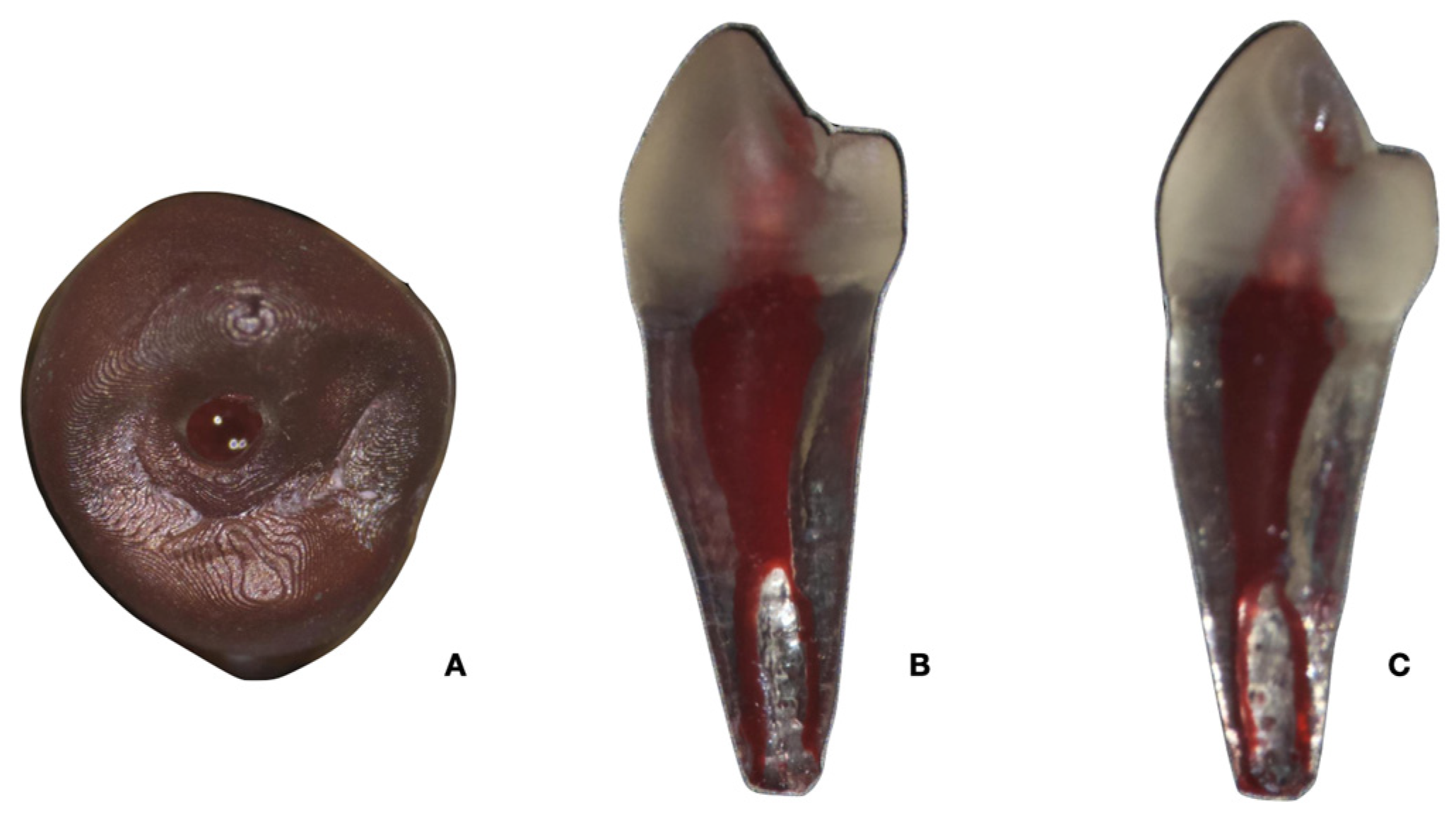

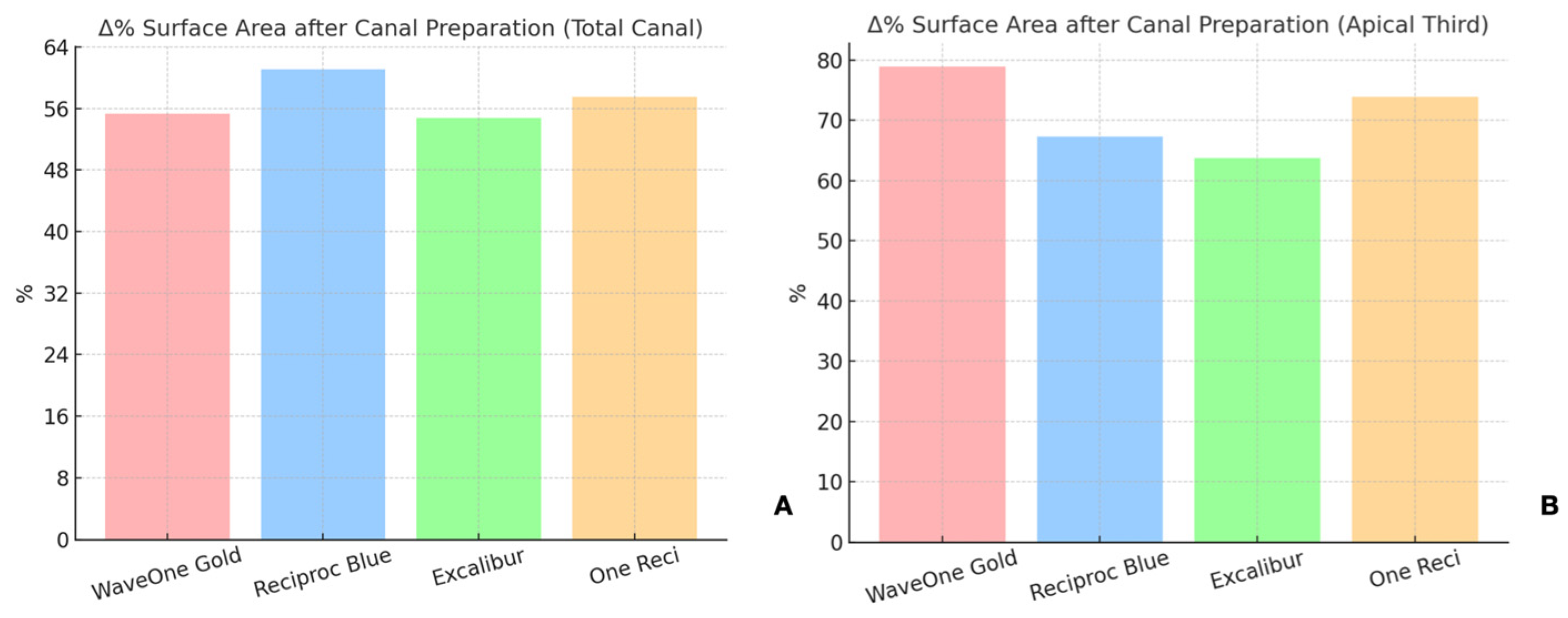
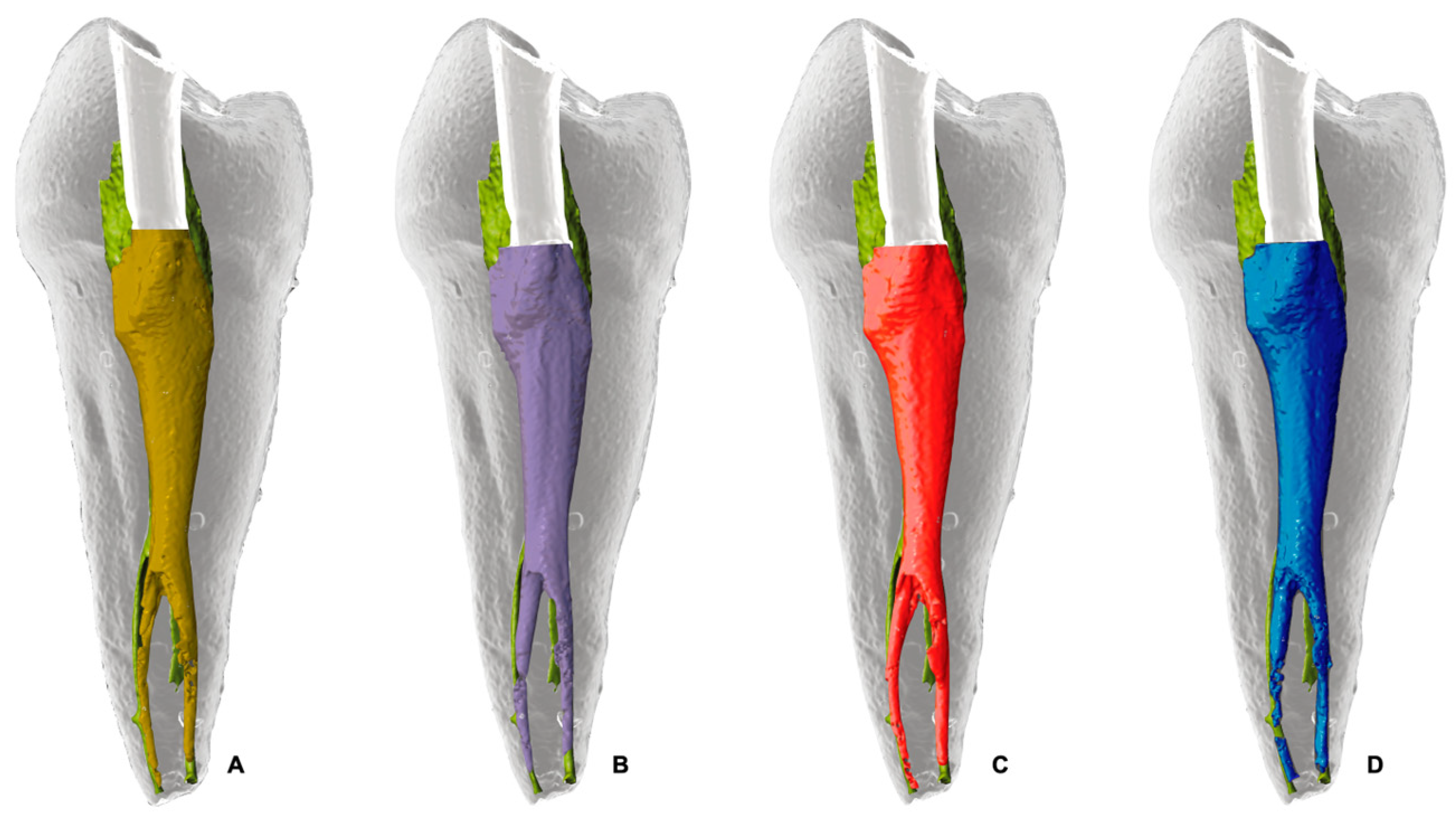
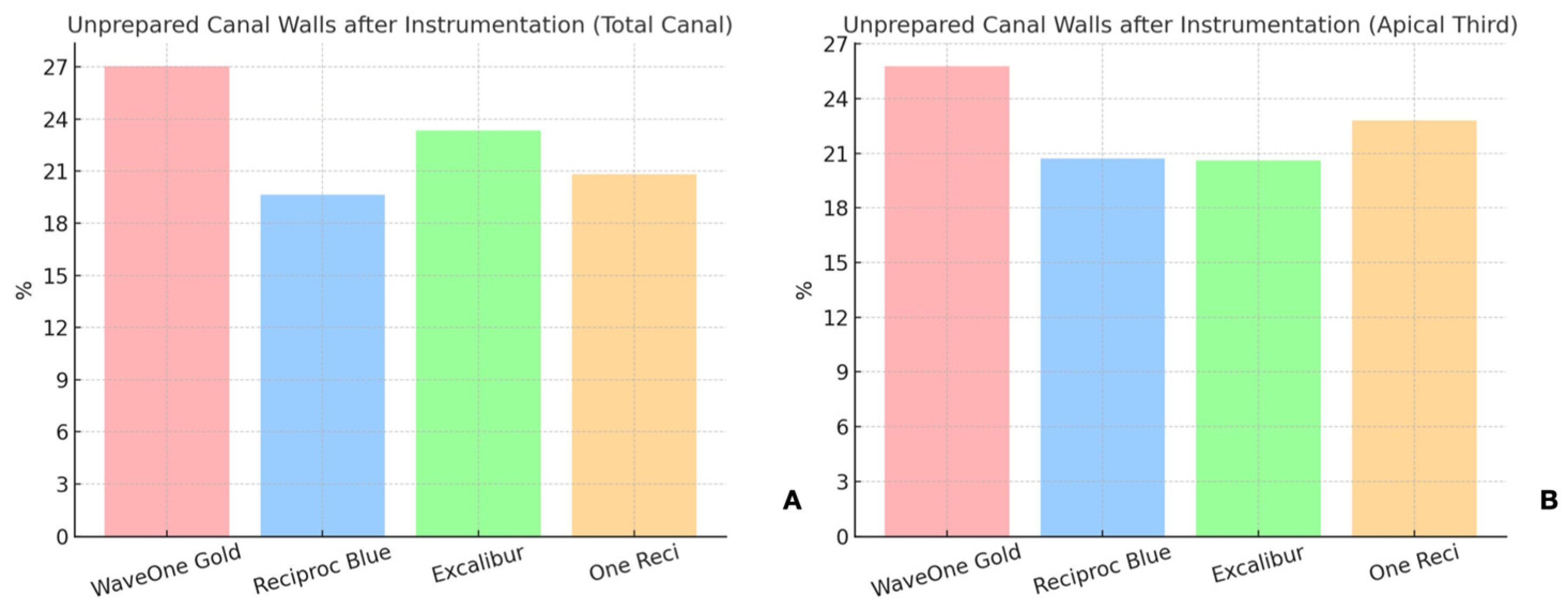
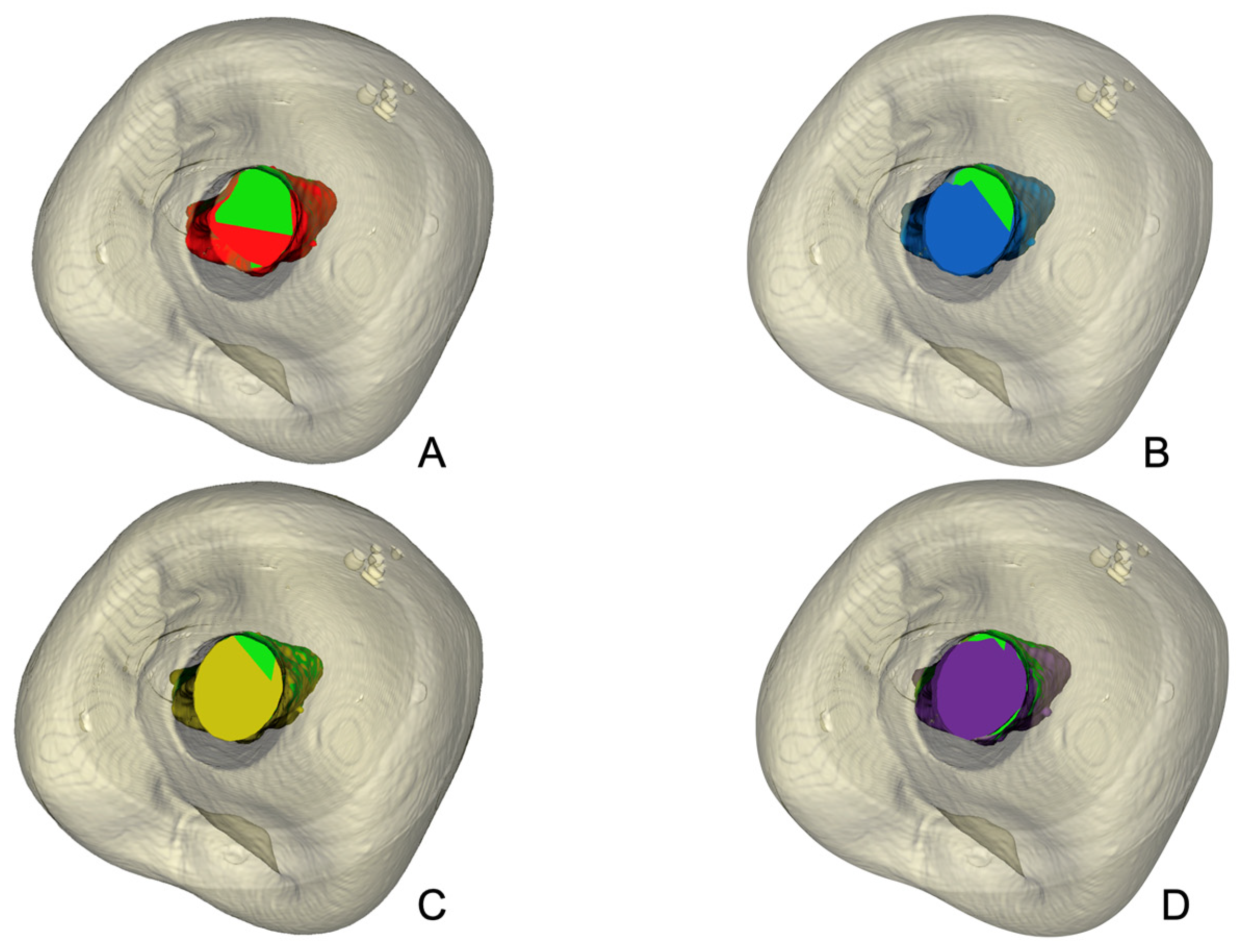
| Data | WaveOne Gold [Mean (Min–Max)] | Reciproc Blue [Mean (Min–Max)] | Excalibur [Mean (Min–Max)] | One Reci [Mean (Min–Max)] |
|---|---|---|---|---|
| Total length (10 mm) | ||||
| Volume (mm3) | ||||
| Initial | 8.18 (2.99–16.79) | 8.17 (2.99–16.79) | 8.16 (2.99–16.79) | 8.19 (16.79) |
| Final | 14.11 (10.30–25.70) | 14.40 (10.35–28.74) | 14.06 (9.85–25.03) | 14.31 (10.37–26.74) |
| Δ% after canal preparation (%) | 86.54 (53.07–253.18) | 90.36 (38.65–282.94) | 86.75 (43.96–263.21) | 89.3 (51.81–259.87) |
| Surface area (mm2) | ||||
| Initial | 64.44 (37.77–129.02) | 62.25 (37.37–129.02) | 64.32 (37.37–129.02) | 64.5 (37.37–129.02) |
| Final | 94.63 (70.98–155.67) | 97.65 (69.82–175.33) | 94.48 (72.44–159.47) | 96.15 (71.47–170.23) |
| Δ% after canal preparation (%) | 55.36 (20.66–197.72) | 61.05 (14.84–256.97) | 54.78 (14.42–194.84) | 57.49 (27.62–210.78) |
| Unprepared root canal walls (%) | 27.03 (11.31–43.31) | 19.65 (9.14–36.39) | 23.33 (9.58–36.93) | 20.85 (9.32–37.03) |
| Apical third (4 mm) | ||||
| Volume (mm3) | ||||
| Initial | 1.02 (0.64–2.25) | 1.06 (0.64–2.25) | 1.04 (0.64–2.25) | 1.05 (0.64–2.25) |
| Final | 1.94 (1.05–3.99) | 1.90 (0.84–4.02) | 1.92 (1.29–3.89) | 1.94 (1.19–3.69) |
| Δ% after canal preparation (%) | 95.24 (42.71–184.71) | 90.64 (31.25–210.59) | 89.41 (24.04–138.82) | 100.67 (23.96–195.29) |
| Surface area (mm2) | ||||
| Initial | 19.65 (12.39–45.60) | 19.75 (12.39–45.60) | 19.43 (12.39–45.60) | 19.32 (12.39–45.60) |
| Final | 34.90 (19.28–85.60) | 33.20 (14.39) | 31.90 (19.50–78.60) | 33.74 (18.51–82.80) |
| Δ% after canal preparation (%) | 78.90 (25.59–152.17) | 67.29 (16.14–184.47) | 63.71 (13.80–103.46) | 73.93 (18.12–157.17) |
| Unprepared root canal walls (%) | 25.76 (10.12–50.95) | 20.70 (7.80–40.43) | 20.59 (10.15–42.95) | 22.80 (10.64–50.58) |
| Instrumentation time (s) | 86.70 (61–122) | 160.80 (47–737) | 129.50 (74–296) | 201.40 (132–477) |
| Pericervical dentin (mm3) | ||||
| Initial | 177.10 (118–93–200.20) | 177.10 (118–93–200.20) | 177.10 (118.93–200.20) | 177.10 (118.93–200.20) |
| Final | 145.26 (100.02–179.16) | 138.52 (89.44–176.76) | 150.42 (101.40–176.93) | 150.19 (101.03–177.62) |
| Δ% After canal preparation | 17.77 (8.05–33.91) | 22.25 (9.28–38.97) | 15.09 (9.20–20.32) | 15.17 (8.84–23.85) |
| Data | WaveOne Gold | Reciproc Blue | Excalibur | One Reci |
|---|---|---|---|---|
| Screw-in | ||||
| Yes | 3 (30%) | 7 (70%) | 3 (30%) | 5 (50%) |
| No | 7 (70%) | 3 (30% | 7 (70%) | 5(50%) |
| Total | 10 (100%) | 10 (100%) | 10 (100%) | 10 (100%) |
Disclaimer/Publisher’s Note: The statements, opinions and data contained in all publications are solely those of the individual author(s) and contributor(s) and not of MDPI and/or the editor(s). MDPI and/or the editor(s) disclaim responsibility for any injury to people or property resulting from any ideas, methods, instructions or products referred to in the content. |
© 2025 by the authors. Licensee MDPI, Basel, Switzerland. This article is an open access article distributed under the terms and conditions of the Creative Commons Attribution (CC BY) license (https://creativecommons.org/licenses/by/4.0/).
Share and Cite
Medina-Gil, M.; Martín-Díaz, A.; Navarrete, N.; Aranguren, J.; Ortolani-Seltenerich, P.S.; Malvicini, G.; Vieira, G.C.S.; Pérez, A.R. Micro-Computed Tomography Analysis of Reciprocating Systems in Three-Dimensional Models of Mandibular Premolars with Two Canals. Dent. J. 2025, 13, 175. https://doi.org/10.3390/dj13040175
Medina-Gil M, Martín-Díaz A, Navarrete N, Aranguren J, Ortolani-Seltenerich PS, Malvicini G, Vieira GCS, Pérez AR. Micro-Computed Tomography Analysis of Reciprocating Systems in Three-Dimensional Models of Mandibular Premolars with Two Canals. Dentistry Journal. 2025; 13(4):175. https://doi.org/10.3390/dj13040175
Chicago/Turabian StyleMedina-Gil, María, Ana Martín-Díaz, Natalia Navarrete, José Aranguren, P. S. Ortolani-Seltenerich, Giulia Malvicini, Gaya C. S. Vieira, and Alejandro R. Pérez. 2025. "Micro-Computed Tomography Analysis of Reciprocating Systems in Three-Dimensional Models of Mandibular Premolars with Two Canals" Dentistry Journal 13, no. 4: 175. https://doi.org/10.3390/dj13040175
APA StyleMedina-Gil, M., Martín-Díaz, A., Navarrete, N., Aranguren, J., Ortolani-Seltenerich, P. S., Malvicini, G., Vieira, G. C. S., & Pérez, A. R. (2025). Micro-Computed Tomography Analysis of Reciprocating Systems in Three-Dimensional Models of Mandibular Premolars with Two Canals. Dentistry Journal, 13(4), 175. https://doi.org/10.3390/dj13040175







